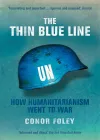The Thin Blue Line: How Humanitarianism Went to War
Written by: Conor Foley,
Verso, New York and London, 2008,
ISBN 9781844672899, 266pp
Reviewed by: Tristan Moss, Australian National University
Since the end of the Cold War the world has seen the significant growth in the profile and importance of humanitarian aid. Running parallel to this is the increasing currency of the concept of ‘humanitarian intervention’, an idea often used as a justification for government action in foreign crisis zones. Conor Foley successfully navigates the complexity of these two issues, offering an engaging study of the provision of aid in crisis zones, both topical and important to Western countries such as Australia.
The central tenet of Foley’s The Thin Blue Line is that those agents that subscribe to the concept of humanitarianism—such as aid agencies, the International Criminal Court and associated individuals—increasingly find themselves grappling with a number of critical dilemmas. These are centred on the conflict between ethical integrity on the one hand, and the necessary evils that are at times required to alleviate suffering on the other.
The chapters devoted to Kosovo and Afghanistan, for instance, examine the increasing ties between providers of aid and the military, and the problems that arise as a result. Military force is increasingly involved in operations with goals that are couched in humanitarian terms, and both the armed forces and providers of aid are more willing to use each other’s resources to achieve common objectives. The erosion of the boundaries between those who traditionally fight wars and those who are supposedly neutral has led to a number of significant problems. The conflict in Afghanistan, for example, has seen aid used to buy allegiances or funnelled into militarily important areas rather than neutrally providing aid to those who need it most, irrespective of their place within the wider conflict.
Elsewhere, the rise of the ‘disaster relief industry’ poses problems for aid agencies that must be reactive to public opinion in order to secure a portion of the outpouring of funds, such as after the 2004 Indian Ocean tsunami. Agencies are now expected to be at the latest humanitarian disaster, irrespective of the actual gravity of the situation. They must apply themselves to each new crisis in the knowledge that there are often other, more deserving peoples. It is indicative of the difficulties facing aid agencies that they received over $7000 for each person affected after the tsunami compared to just $3.00 per person for floods in Bangladesh the previous year.
Foley’s use of contemporary examples of the moral dangers inherent in the provision of humanitarian aid creates a strong case for the need for increased ‘humanitarian accountability’. The Thin Blue Line presents a reasoned critique of the aid situation in the world today; quite rightly, however, it does not suggest a silver bullet. Rather, he argues, the erosion of the integrity of those providing aid, and their lack of accountability represents the greatest impediment to improving the lot of disaster and conflict victims. If aid providers continue to misinform the public about the realities of crises, instead chasing funding through the emphasis of catastrophe and promising unachievable solutions (or any solutions at all), there is a very real danger of humanitarian aid doing more harm than good.
While the topic is of a political nature, The Thin Blue Line is, happily, not mired in theory or otherwise abstract arguments. Instead, Foley’s own experiences are placed at the centre of his examination of humanitarianism. This insight lends weight to his arguments and no doubt furnished Foley with the raw material from which to build his criticisms of the humanitarian aid industry. However, in some cases, further knowledge of areas on the periphery of his expertise would have added to the strength of the book. Foley asserts, for example, that humanitarianism has not been subject to academic study; however, a number of academics, most notably Michael Walzer, have examined humanitarian intervention.
‘First, do no harm’ is, or should be, the central mantra of all those engaged in providing aid to those facing destruction or starvation. Conor Foley provides a timely warning that this is not always the case. This is not a polemic on aid or its misuse; rather, it is a well argued and thought provoking study of the dangers, the misuse and misunderstanding of the important concept of humanitarianism.

